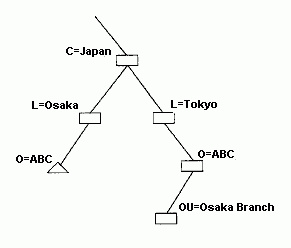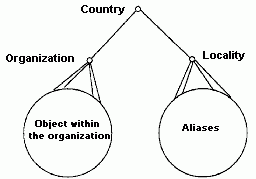
An alternative name or alias is supported in the DIT by the use of special pointer entries called alias entries. Alias entries do not contain any other attributes beyond their distinguished attributes, the object class attribute, and the aliased object name attribute; that is, the distinguished name of the aliased object entry. Furthermore, an alias entry has no subordinate entries, making it, by definition, a leaf entry of the DIT as shown in the following figure. Alias entries point to object entries and provide the basis for alternative names for the corresponding objects.
Aliases are used to do such things as provide more user-friendly names, direct the search for a particular entry, reduce the scope of a search, provide for common alternate abbreviations and spellings, or provide continuity after a name change.
The following figure demonstrates how an alias name provides continuity after a name change. The ABC company's branch office located originally in Osaka has moved to Tokyo. To make the transition easier for directory service users and to guarantee that a search based on the old information finds its target, an alias for O=ABC has been added to the directory beneath L=Osaka. This alias entry points to the object entry O=ABC. A search for ABC under L=Osaka in the DIT finds the entry /C=Japan/L=Tokyo/O=ABC.
An Alias in the Directory Information Tree

Another use of alias entries is as an alternative to filtering; that is, by using assertions about particular attributes to search through the DIT. Although this approach does not require any special information to be set up in the DIT, it can be expensive to search where there is a large population of entries and attributes. An alternative approach is to set up special subtrees whose naming structures are designed for Yellow Pages type searching. The following figure shows an example of such a subtree populated by alias entries only. In reality, the entries within these subtrees can be a mixture of object and alias entries, as long as there exists only one object entry for each object stored in the directory.
A Subtree Populated by Aliases

An object with an entry in the DIT can have zero or more aliases. Several alias entries can point to the same object entry. An alias entry can point to an object that is not a leaf entry. Only object entries can have aliases. Thus, aliases of aliases are not permitted.